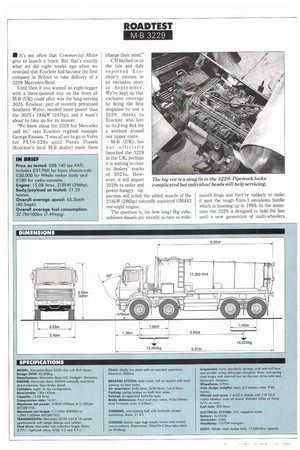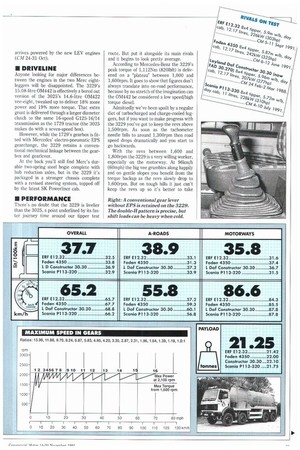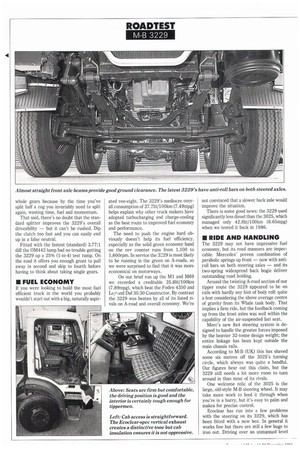• It's not often that Commercial Motor gets to launch
Page 32

Page 33

Page 34

Page 35

If you've noticed an error in this article please click here to report it so we can fix it.
a truck. But that's exactly what we did eight weeks ago when we revealed that Ecoclear had become the first company in Britain to take delivery of a 3229 Mercedes-Benz.
Until then if you wanted an eight-legger with a three-pointed star on the front all M-B (UK) could offer was the long-serving 3025. Ecoclear, part of recently privatised Southern Water, needed more power than the 3025's 184kW (247hp), and it wasn't about to take no for an answer.
"We knew about the 3229 but Mercedes said no," says Ecoclear regional manager George Fassam. "I was all set to go to Volvo for FL10-320s until Panda Diesels (Ecoclear's local M-B dealer) made them
change their mind."
CMlatched on to the tale and duly reported Ecoclear's success in an exclusive story in September. We've kept up that exclusive coverage by being the first magazine to test a 3229, thanks to Ecoclear who lent us its J-reg 8x4 for a workout around our tipper route.
M-B (UK) has not officially launched the 3229 in the UK; perhaps it is waiting to clear its dealers' stocks of 3025s. However, it will import 3229s to order and power-hungry tippermen will relish the added muscle of the 218kW (296hp) naturally aspirated 0M442 vee-eight engine.
The question is, for how long? Big cube, unblown diesels are already as rare as wide
mouth frogs and they're unlikely to make it past the tough Euro-1 emissions hurdle which is looming up in 1993. In the meantime the 3229 is designed to hold the line until a new generation of multi-wheelers
arrives powered by the new LEV engines (CM 24-31 Oct).
• DRIVELINE
Anyone looking for major differences between the engines in the two Merc eightleggers will be disappointed. The 3229's 15.08-litre 0M442 is effectively a bored out version of the 3025's 14.6-litre 0M422 vee-eight, tweaked up to deliver 18% more power and 19% more torque. That extra grunt is delivered through a larger diameter clutch to the same 16-speed G125-16/14 transmission as the 1729 tractor (the 3025 makes do with a seven-speed box).
However, while the 1729's gearbox is fitted with Mercedes' electro-pneumatic EPS gearchange, the 3229 retains a conventional mechanical linkage between the gearbox and gearlever.
At the back you'll still find Merc's durable two-spring steel bogie complete with hub reduction axles, but in the 3229 it's packaged in a stronger chassis complete with a revised steering system, topped off by the latest SK Powerliner cab.
• PERFORMANCE
There's no doubt that the 3229 is livelier than the 3025, a point underlined by its faster journey time around our tipper test route. But put it alongside its main rivals and it begins to look pretty average.
According to Mercedes-Benz the 3229's peak torque of 1,112Nm (8201bft) is delivered on a "plateau" between 1,000 and 1,600rpm. It goes to show that figures don't always translate into on-road performance, because by no stretch of the imagination can the 0M442 be considered a low speed/high torque diesel.
Admittedly we've been spoilt by a regular diet of turbocharged and charge-cooled luggers, but if you want to make progress with the 3229 you've got to keep the revs above 1,500rpm. As soon as the tachometer needle falls to around 1,300rpm then road speed drops dramatically and you start to go backwards.
With the revs between 1,600 and 1,800rpm the 3229 is a very willing worker, especially on the motorway. At 96km/h. (60mph) the big vee grumbles along happily and on gentle slopes you benefit from the torque backup as the revs slowly drop to 1,600rpm. But on tough hills it just can't keep the revs up so it's better to take Right: A conventional gear lever without EPS is retained on the 3229. The double-H pattern is precise, but shift loads can be heavy when cold.
whole gears because by the time you've split half a cog you invariably need to split again, wasting time, fuel and momentum.
That said, there's no doubt that the standard splitter improves the 3229's overall driveability — but it can't be rushed. Dip the clutch too fast and you can easily end up in a false neutral.
Fitted with the fastest (standard) 3.77:1 diff the 0M442 lump had no trouble getting the 3229 up a 25% (1-in-4) test ramp. On the road it offers you enough grunt to pull away in second and skip to fourth before having to think about taking single gears.
• FUEL ECONOMY
If you were looking to build the most fuel efficient truck in the world you probably wouldn't start out with a big, naturally aspir ated vee-eight. The 3229's mediocre overall consumption of 37.71it/100km (7.49mpg) helps explain why other truck makers have adopted turbocharging and charge-cooling as the best route to improved fuel economy and performance.
The need to push the engine hard obviously doesn't help its fuel efficiency, especially as the solid green economy band on the rev counter runs from 1,100 to 1,600rpm. In service the 3229 is most likely to be running in the green on A-roads, so we were surprised to find that it was more economical on motorways.
On our brief run up the MI and M69 we recorded a creditable 35.81it/100km (7.89mpg), which beat the Foden 4350 and Leyland Daf 30.30 Constructor. By contrast the 3229 was beaten by all of its listed rivals on A-road and overall economy. We're not convinced that a slower back axle would improve the situation.
There is some good news: the 3229 used significantly less diesel than the 3025, which managed only 42.81it/100Iun (6.65mpg) when we tested it back in 1986.
• RIDE AND HANDLING
The 3229 may not have impressive fuel economy, but its road manners are impeccable. Mercedes' proven combination of parabolic springs up front — now with antiroll bars on both steering axles — and its two-spring widespread back bogie deliver outstanding road holding.
Around the twisting A-road section of our tipper route the 3229 appeared to be on rails with hardly any hint of body roll: quite a feat considering the above average centre of gravity from its Whale tank body. That implies a firm ride, but the feedback coming up from the front axles was well within the capability of the air-suspended Isri seat.
Merc's new 8x4 steering system is designed to handle the greater forces imposed by the heavier 32-tonne design weight; the entire linkage has been kept outside the main chassis rails.
According to M-B (UK) this has shaved some six metres off the 3025's turning circle, which always was quite a handful. Our figures bear out this claim, but the 3229 still needs a lot more room to turn around in than most of its rivals.
One welcome relic of the 3025 is the large, old-style M-B steering wheel. It may take more work to feed it through when you're in a hurry, but it's easy to palm and makes for precise control.
Ecoclear has run into a few problems with the steering on its 3229, which has been fitted with a new box. In general it works fine but there are still a few bugs to iron out. Driving over an unmanned level crossing set up an unpleasant wig-wag on the wheel which took a while to die down.
The 3229 boasts bigger brakes than the 3025 and they work well, almost too well in fact. A little more progression would not go amiss.
• CAB COMFORT
Access into the latest SK cab is no problem. The bottom step is hinged front and back so if it does hit the ground it will go with the flow; a nice touch. The interior is typical Daimler-Benz: practical, hard-wearing and short of frills. Just the way a tipper cab should be.
Storage is inevitably limited in a day cab. The 3229 makes do with door pockets, headliner trays and a space behind the seats. The dashboard is a good lesson in restraint with all the main instruments clearly visible. We're equally satisfied with the controls.
The heater is certainly efficient our problem was getting enough cold air on a hot day until we stopped fiddling with the control and opened the quarterlights and standard roof hatch. Problem solved.
• SUMMARY
Mercedes' 3025 has earned a reputation as a rugged eight-legger and the 3229 looks set to continue the legend.
If you're looking for blistering performance or maximum fuel economy this is not the truck for you, but its big vee will prob
ably be beating long after many smaller, higher stressed rivals have called it a day.
The 3229's strongest suit is its excellent handling. Back that up with a practical, well-built cab and you have an eight-legger that will be popular with drivers and operators alike.
The Germans have never been known for lightweight chassis; as our body/payload chart shows this is no exception. But the 3229's extra weight derives as much from its stout chassis as that heavy vee-eight.
And so to the bottom line. At £57,960 the Merc is more expensive than the ERF E12.32, Leyland Daf FAD 80.270, Volvo FL10, Eagle Tx-powered Seddon Atkinson Strato TC, or MAN 30.292. At £59,668 Scania's fuel-efficient P113-320 is pricier, but in any case list price has little relevance in the depths of a recession: operators who don't need too many horses might be well advised to go for a 3025 and demand a good price from a dealer keen to shift a chassis.
0 by Brian Weatherley




















































































